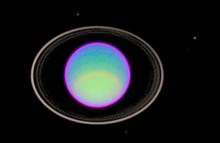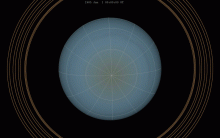Listen to today's episode of StarDate on the web the same day it airs in high-quality streaming audio without any extra ads or announcements. Choose a $8 one-month pass, or listen every day for a year for just $30.
You are here
Uranus at Opposition
If you want to lose a little weight in a hurry, visit the planet Uranus. Its surface gravity is less than 90 percent as strong as Earth’s. So if you weigh 180 pounds here, you’d tip the scales at less than 160 pounds on Uranus — instant weight loss, with no dieting or exercise required.
As with many weight-loss ideas, though, there’s a catch: There’s no “surface” to stand on. The giant planet’s atmosphere gets denser as you descend. Eventually, it merges with the layer below, which consists of hot, dense fluids. So if you dropped into the atmosphere, you’d never hit a solid surface. Instead, you’d be crushed by increasing pressure, vaporized by increasing temperatures, or both.
For planets with no surface, scientists designate a hypothetical one. It’s the depth in the atmosphere where the pressure equals the surface pressure on Earth. That makes it easier to compare planets.
The atmosphere of Uranus consists mainly of hydrogen and helium, with a bit of methane, water vapor, ammonia, and other compounds. The water vapor sometimes forms ribbons of bright clouds. And the methane absorbs red light, giving the planet a blue-green color.
If you have a telescope, that color is especially evident right now. That’s because Uranus is lining up opposite the Sun. It rises at sunset and is in view all night. It’s also closest and brightest for the year — shining like a faint star in the constellation Aries.
More on Uranus tomorrow.
Script by Damond Benningfield





